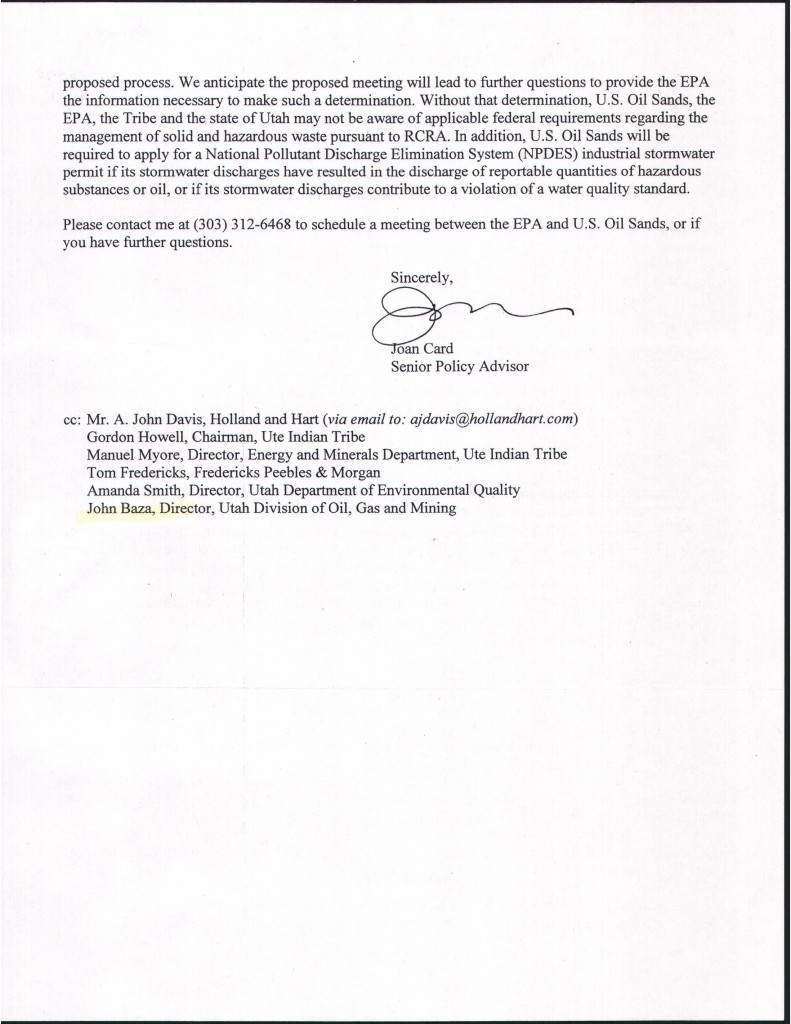Land defenders shut down work for a full week at U.S. Oil Sands tar sands strip-mine in Utah last month, after learning that the project is actually located on land straddling the boundary of the Uintah and Ouray Reservation. As such, the EPA has jurisdiction to require further permitting, and even shut the project down all together. Call the EPA at 1-800-227-8917 and tell them “no tar sands in Indian country!”
We’d like to highlight this part of the letter, as it does not bode well for the future of U.S. Oil Sands’ tar sands strip-mine:
“Regarding your question concerning jurisdiction, the U.S. Oil Sands proposed project is located on land straddling the boundary of the Uintah and Ouray Reservation. Portions of the proposed project in Township 15S, Range 23E, Sections 35 and 36 are on the north side of the boundary and are within the Uintah and Ouray Reservation, while the parts in Township 15S, Range 24E, Sections 31 and 32 would be outside of the reservation. Land located within Uintah and Ouray Reservation is Indian country, as that term is defined at 18 U.S.C. 1151 and as held in Ute Indian Tribe v. Utah 114 F.3d 1513 (10th Cir. 1997), cert. denied, 522 U.S. 1107 (1998). Please note that as defined by 18 U.S.C. 1151, Indian country includes all reservation lands, including lands owned by non-members of the relevant tribes. The EPA implements federal environmental programs in Indian country, unless it has explicitly approved a tribe or a state to do so. The EPA has not approved the Ute Indian Tribe or the state of Utah to implement any federal environmental regulatory program on Indian country within the Uintah and Ouray Reservation.”
On July 22nd, John Andrews, chief general counsel for SITLA (the state agency that leased the land to U.S. Oil Sands in the first place), even confirmed that part of the project is within the boundaries of the historic Uncompahgre Indian Reservation.



Pingback: SEHN | Utah is Ground Zero for the Fight Over Unconventional Energy Development
Pingback: Our 2015 Protest Vigil Has Launched! | Utah Tar Sands Resistance
What are the Basic Steps in Making Bevill Determinations?
Determine whether the material is considered a solid waste under RCRA.
Determine whether the facility is using a primary ore or mineral to produce a final or intermediate product and also whether less than 50 percent of the feedstocks on an annual basis are from secondary sources.
Establish whether the material and the operation that generates it are uniquely associated with mineral production.
Determine where in the sequence of operations beneficiation ends and mineral processing begins.
The above letter states that USEPAis making their first Bevill Determination for Tar Sands. hmmm, What is that?
Well, the USEPA webpage at http://www.epa.gov/compliance/assistance/sectors/minerals/processing/bevilltraining.html#bevillexclusion
sez–>
What are the Basic Steps in Making Bevill Determinations?
Determine whether the material is considered a solid waste under RCRA.
Determine whether the facility is using a primary ore or mineral to produce a final or intermediate product and also whether less than 50 percent of the feedstocks on an annual basis are from secondary sources.
Establish whether the material and the operation that generates it are uniquely associated with mineral production.
Determine where in the sequence of operations beneficiation ends and mineral processing begins.
If the material is a mineral processing waste, determine whether it is one of the 20 special wastes from mineral processing.
This analytical sequence will result in one of three outcomes:
the material is not a solid waste and therefore not subject to RCRA;
the material is a solid waste but is exempt from RCRA Subtitle C because of the Mining Waste Exclusion; or
the material is a solid waste that is not exempt from RCRA Subtitle C and is subject to regulation as a hazardous waste if it is a listed or characteristic hazardous waste.
So apparently this Bevill determination is pretty importat to USOS profits. Like if they cannot just dump their toxic crap in unlined pits well then costs would go up.
What are the Basic Steps in Making Bevill Determinations?
Determine whether the material is considered a solid waste under RCRA.
Determine whether the facility is using a primary ore or mineral to produce a final or intermediate product and also whether less than 50 percent of the feedstocks on an annual basis are from secondary sources.
Establish whether the material and the operation that generates it are uniquely associated with mineral production.
Determine where in the sequence of operations beneficiation ends and mineral processing begins.
The above letter states that USEPAis making their first Bevill Determination for Tar Sands. hmmm, What is that?
Well, the USEPA webpage at http://www.epa.gov/compliance/assistance/sectors/minerals/processing/bevilltraining.html#bevillexclusion
sez–>
What are the Basic Steps in Making Bevill Determinations?
Determine whether the material is considered a solid waste under RCRA.
Determine whether the facility is using a primary ore or mineral to produce a final or intermediate product and also whether less than 50 percent of the feedstocks on an annual basis are from secondary sources.
Establish whether the material and the operation that generates it are uniquely associated with mineral production.
Determine where in the sequence of operations beneficiation ends and mineral processing begins.
If the material is a mineral processing waste, determine whether it is one of the 20 special wastes from mineral processing.
This analytical sequence will result in one of three outcomes:
the material is not a solid waste and therefore not subject to RCRA;
the material is a solid waste but is exempt from RCRA Subtitle C because of the Mining Waste Exclusion; or
the material is a solid waste that is not exempt from RCRA Subtitle C and is subject to regulation as a hazardous waste if it is a listed or characteristic hazardous waste.
So apparently this Bellvil determination is pretty importat to USOS profits. Like if they cannot just dump their toxic crap in unlined pits well then costs would go up.